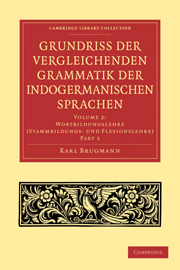Book contents
- Frontmatter
- Vorwort
- Contents
- Verbesserungen und Nachträge
- Wortbildungslehre (Stammbildungs- und Flexionslehre)
- Nominale (und pronominale) Stammbildung und Flexion
- Nominale Zusammensetzung (Nominalcomposita)
- Reduplicierte Nominalbildungen
- Nomina mit stammbildenden Suffixen
- Nomina ohne stammbildende Suffixe (Wurzelnomina)
Nomina ohne stammbildende Suffixe (Wurzelnomina)
Published online by Cambridge University Press: 10 November 2010
- Frontmatter
- Vorwort
- Contents
- Verbesserungen und Nachträge
- Wortbildungslehre (Stammbildungs- und Flexionslehre)
- Nominale (und pronominale) Stammbildung und Flexion
- Nominale Zusammensetzung (Nominalcomposita)
- Reduplicierte Nominalbildungen
- Nomina mit stammbildenden Suffixen
- Nomina ohne stammbildende Suffixe (Wurzelnomina)
Summary
159. Wurzelnomina nennen wir solche Nomina, die eine Zerlegung in Wurzel und stammsuffixales Element nicht zulassen, in deren Stammausgang ein aueh sonst in gleicher Function vorkommendes nominales Bildungselement nicht erscheint. Ob alle Nomina, die hiernach als Wurzelnomina zu bezeichnen sind, in der That auch von allem Anfang an einfache Gebilde waren, muss freilich dahin gestellt bleiben. Manche, z. B. ai. div- ‘Himmel’ und lat. hiem- (s. u.), mögen im letzten Grunde doch complicierte Formen gewesen sein.
Wurzelnomina finden sich in alien Sprachzweigen, die meisten im Arischen und in den classischen Sprachen. Vielfach verloren sie ihren eigentiimlichen Bildungscharakter dadurch, dass sie in die Analogie einer vocalischen Declination einlenkten (vgl. § 56 S. 97 f.), und eben dieser Declinationswechsel ist nachweislich der Hauptgrund für ihr verhältnissmässig seltenes Auftreten im Armenischen und im Germanischen) und für ihren fast völligen Verlust im Baltisch-Slavischen. Wir werden aber überall diejenigen Nomina der einzelnen Sprachen, die nur durch einen solchen für die Wortbedeutung gleichgiltigen Declinationswechsel ihren Charakter als Wurzelnomina einbüssten, mit zu berücksichtigen haben.
Eine einheitliche, fest ausgeprägte Function (Concretbebenennung, nomen actionis u. dgl.) zeigen die Wurzelnomina nicht. Auch diejenigen, welche sich als uridg. erweisen, haben verschiedenartige Bedeutungen. Die nicht zusammengesetzten sind meist Substantiva, und unter diesen wiegen die nomina actionis (gen. fern.) und die nomina agentis vor; jene Kategorie ist besonders auch durch den inflnitivischen Gebrauch im Arischen, Griechischen und Lateinischen vertreten.
- Type
- Chapter
- Information
- Publisher: Cambridge University PressPrint publication year: 2010First published in: 1892



